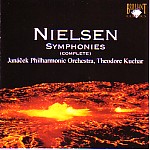Theodore Kuchar leads what is without question the most exciting complete Nielsen symphony cycle available, making this the set to get for Nielsen newcomers. He doesn’t put a foot wrong in any of these symphonies, and it’s rather amazing to hear how well he handles passages where so many conductors come to grief. For example, the finale of the Second Symphony has tremendous physicality at an aptly swift tempo. So often it’s taken way too slowly. Kuchar gets all the tempo relationships right in the tricky finale of the Fourth as well, and he drives the Fifth home with such exultant power that for once that second movement doesn’t sound like an anticlimax, coming as it does after perhaps the most inspired 20 minutes of music that Nielsen ever penned. Kuchar also isn’t at all fazed by the weirdness of the Sixth, its concluding Theme and Variations in particular. Here’s a case where simply playing what’s written as characterfully as possible really does produce the desired wacky effect far better than any sort of poking and prodding. You simply won’t hear a finer performance anywhere. Kuchar is equally sensitive to Nielsen’s ear for color–those special moments of startling sonic innovation. I’m thinking of the trumpet tremolos before the grand waltz in the Espansiva’s opening movement, or the timpani roll with brushes in the slow movement of the Second.
However, despite the all-around interpretive excellence, it has to be admitted that the orchestra is not quite in the first class, at least as compared to those of San Francisco (Blomstedt/Decca) or Denmark (Schonwandt/dacapo). Don’t get me wrong: they play spectacularly well, all things considered. The strings take Nielsen’s ungrateful passagework in stride, rhythms are firm, and the ensemble is excellently balanced. Tricky episodes such as the tuba and woodwind exchanges in the finale of the Fifth come off splendidly. Still, there’s a certain want of sheer amplitude in the biggest climaxes, such as the conclusion of the Fourth Symphony (after a fabulous timpani duel), or the snare drum-led battle in the first movement of the Fifth. The truth is, even here Kuchar is as good or better than most of the competition, but by the same token, and however minor this point is in the grand scheme of things, the above observations are real and something that Nielsen fans are likely to notice.
This doesn’t mean you should hesitate for a minute in buying this inexpensive set, which also is very naturally and vibrantly recorded. What it does mean is that this joins the two other cycles just mentioned (and Rozhdestvensky’s as well on Chandos) among the top picks, rather than sweeping the board. And if I sound just a touch frustrated, it’s only because Kuchar’s conducting really does sweep the board. Given a choice of who I would likely listen to in this music on any given day, Kuchar is the man, and I suspect that you’ll agree. He’s that good.
































